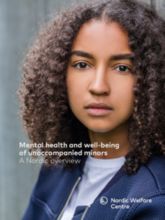

Displaying 551 - 560 of 1633
For this study, one hundred and twenty‐six 11–21 year olds (53 who had experience of the care system and 73 who did not) were recruited from the community and NHS. All participants had self‐harmed in the past 6 months. Participants completed an Audio Computer‐Assisted Self‐interview (ACASI) regarding their views about the support they had received, how helpful it was, and what further help they felt they needed.
In the present study, six unaccompanied asylum‐seeking minors (UASMs) were interviewed and interpretative phenomenological analysis (IPA) was used as a methodology to analyse the data.
This research aimed to construct an explanatory theory of how residential staff make sense of, and use, attachment theory in practice.
In this piece for the Guardian, an anonymous foster carer writes about their experience caring for an unaccompanied asylum-seeking child (UASC) in the UK.
This paper from the Children and Youth Services Review reflects on the collective participation of young people in care in a rights-based initiative intended to facilitate input into service and policy development in Ireland.
The purpose of this study was to examine the lived experiences of posttraumatic growth (PTG) in adult survivors of institutional childhood abuse in Ireland.
This independent evaluation found that the Pause Programme - which supports local practices to deliver relationship-based support to women who have experienced removal of at least one child and are judged to be at risk of further removals of children - is effective in making a positive difference in women’s lives, improving their relationships with children, reducing rates of infant care entry in local areas and delivering cost savings for local areas.
This report presents the findings from a study of the organisational and institutional context of statutory children’s social care (CSC) in England and its contribution to inequalities in provision.
This report presents findings from an independent analysis of the responses to a public consultation issued by the Scottish Government in September 2019, which invited views on its specific proposals for the establishment of a statutory financial redress scheme for victims / survivors of abuse in care.
This report surveys different aspects of health of unaccompanied minors who have arrived in the Nordic region.




